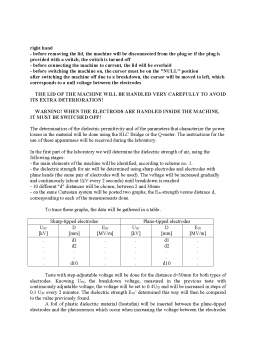Extras din laborator
Study of dielectric materials
Purpose of the application
The purpose of this application is the study of dielectric materials. Certain characteristic parameters of the dielectric materials will be determined such as electric permittivity, dielectric rigidity. The theory necessary for this application is found in the course at 1.1 and 1.2 subchapters.
Introduction
The dielectric rigidity is determined with the help of the circuit showed in figure 1.
Material tests are run at 50Hz frequency at alternative voltage.
Fig 1
Figure 1 Installation simplified electric scheme for dielectric rigidity determination.
Voltage value between electrodes modifies with the help of the autotransformator AT.
To start the dielectric rigidity determination we press the start button BP, powering the voltage relay coil Rt which will determine the closing of Rt1, which maintains the voltage thru the voltage relay coil Rt even after the button BP is no longer pressed (auto hold relay). Rt1 closes in the same time as contact Rt2 closes which allows the voltage way thru the primary of the voltage raising transformer TR to close (high voltage transformer).For the auto maintaining relay to start the BB1 contact needs to close which is done by correct positioning of the installation cap. The voltage of the primary of TR is transformed into kilovolts in the secondary of RT such that between the electrodes E1 and E2 we can apply a voltage of up to 40kV. The shut down of the circuit can be done in two ways. We can press the stop button BP which stops voltage thru the voltage relay coil Rt that determines opening of the contacts Rt1 and Rt2 which interrupts voltage circulation thru the primary and the secondary of the transformer TR. The Circuit also stops when we have a breech in the material between the electrodes. When the breech occurs the dielectric material becomes conductive and a short circuit occurs in the secondary of TR which leads to a rise in voltage in the primary of TR overflow of voltage detected by de voltage relay coil Rc, which determines Rc contact opening that is normally closed. The opening of Rc has the same effect as pressing the BO button.
In order to determine the dielectric strength, the voltage for which the machine automatically disconnects must be known and also the distance between the electrodes.
Because we work with high voltages of about 40kV, the following safety instructions must be read carefully and implemented:
- we search for the connection between the ground plug and the machine shell
- the adjustment of the voltage between the electrodes is done by a single person with the right hand
- before removing the lid, the machine will be disconnected from the plug or if the plug is provided with a switch, the switch is turned off
- before connecting the machine to current, the lid will be overlaid
- before switching the machine on, the cursor must be on the "NULL" position
after switching the machine off due to a breakdown, the cursor will be moved to left, which corresponds to a null voltage between the electrodes
THE LID OF THE MACHINE WILL BE HANDLED VERY CAREFULLY TO AVOID ITS EXTRA DETERIORATION!
WARNING! WHEN THE ELECTRODS ARE HANDLED INSIDE THE MACHINE, IT MUST BE SWITCHED OFF!
The determination of the dielectric permittivity and of the parameters that characterize the power losses in the material will be done using the RLC Bridge or the Q-meter. The instructions for the use of these apparatuses will be received during the laboratory.
In the first part of the laboratory we will determine the dielectric strength of air, using the following stages:
- the main elements of the machine will be identified, according to scheme no. 1.
- the dielectric strength for air will be determined using sharp electrodes and electrodes with plane heads (the same pair of electrodes will be used). The voltage will be increased gradually and continuously (about 1kV every 2 seconds) until breakdown is reached
- 10 different "d" distances will be chosen, between 2 and 30mm
- on the same Cartesian system will be posted two graphs, the Estr strength versus distance d, corresponding to each of the measurements done.
Preview document
Conținut arhivă zip
- Study of Dielectric Materials.doc



